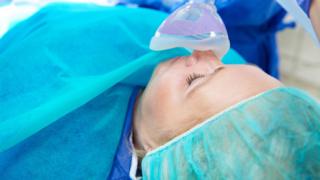Anaesthetic Devices Vulnerable To Hackers
 Image copyright Getty Images
Image copyright Getty Images A type of anaesthetic machine that has been used in NHS hospitals can be hacked and controlled from afar if left accessible on a hospital computer network, a cyber-security company says.
A successful attacker would be able to change the amount of anaesthetic delivered to a patient, CyberMDX said.
Alarms designed to alert anaesthetists to any danger could also be silenced.
GE Healthcare, which makes the machines, said there was no “direct patient risk”.
But CyberMDX’s research suggested the Aespire and Aestiva 7100 and 7900 devices could be targeted by hackers if left accessible on hospital computer networks.
And analysis by BBC News found multiple references online to the Aespire and Aestiva machines being used in NHS Hospitals.
Nottingham University Hospitals (NUH) NHS Trust confirmed to the BBC that “a small number” of the devices were currently in use at its facilities, but were being phased out.
“None of the anaesthetic machines are connected to the internet or the NUH network so there is very little risk around these machines within NUH,” a spokesman told the BBC.
NHS Digital said it could not confirm the extent to which the machines were still in use across the NHS.
“We are currently assessing the volume of these particular anaesthetic machines in use across England and we will be sharing any subsequent advice with trusts in the coming days,” a spokeswoman said.
Elad Luz, head of research at CyberMDX, said he was aware of hospitals in the US and Asia that also used the devices.
GE Healthcare said it was satisfied a cyber-attack would “not introduce clinical hazard or patient risk”.
It said this was because anaesthetic devices were “attended” by anaesthetists and would be monitored for any errors.
The company told BBC News it did not plan to release any security updates for the anaesthetic machines but hospitals should use secure network protocols to protect them from would-be hackers.
Cyber-security expert Ken Munro agreed that medical devices should be isolated within computer networks but added: “It’s not, frankly, the case in many hospital networks.”
And he said GE Healthcare should bear some responsibility for the issue.
“GE absolutely have a part to play in this and they absolutely should be building devices with strong security,” Mr Munro added.
A malicious hacker may try to gain access to a hospital’s network, locate one of the machines and then adjust its settings, said Prof Harold Thimbleby, an expert in medical device cyber-security, at Swansea University.
And he gave the example of WannaCry, a ransomware outbreak that spread through NHS computer networks in 2017, to illustrate how an attack could unfold.
“As with WannaCry, a phishing attack can gain access and then an attacker can do what they like,” he told BBC News.
“Given the worldwide profile of WannaCry, it is amazing vulnerabilities like this are still around.”
The likelihood of harm being caused to a patient through any hacking of the devices was “incredibly small” said Dr Helgi Johannsson, consultant anaesthetist and Royal College of Anaesthetists Council Member.
“Patients should be reassured that their anaesthetist will be monitoring them constantly, and will have received many years of training to rectify immediately the situation of a device failure.”
A spokeswoman for the UK’s Medicines and Healthcare products Regulatory Agency said reports of the cyber-security vulnerability were now part of an “ongoing area of investigation”.
“Patient safety is our highest priority and where necessary we will take action to protect public health,” she added.
The US Department of Homeland Security’s Industrial Control Systems Cyber Emergency Response Team (ICS-CERT) has published an advisory notice about the vulnerability.
READ MORE HERE



